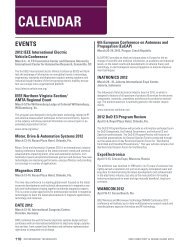2011 EMC Directory & Design Guide - Interference Technology
2011 EMC Directory & Design Guide - Interference Technology
2011 EMC Directory & Design Guide - Interference Technology
Create successful ePaper yourself
Turn your PDF publications into a flip-book with our unique Google optimized e-Paper software.
testing & test equipment<br />
M e a s ur e m e n t Un c e r ta in t y f o r C o nduc t e d, R a di at e d Emi s s i o n s<br />
United Kingdom Accreditation<br />
Service - LAB34 - The Expression of<br />
Uncertainty in <strong>EMC</strong> Testing - Edition<br />
1 - August 2002.<br />
Two Examples of Measurement<br />
Uncertainty – Conducted<br />
Emissions and Radiated<br />
Emissions<br />
The following paragraphs go into detail<br />
on the MU for instrumentation<br />
for conducted and radiated emissions.<br />
The presentation of the table is different<br />
from what is seen in the usual MU<br />
references; namely CISPR 16-4-2 and<br />
LAB34.<br />
First of all, we have listed our<br />
Sources of Uncertainty in the two<br />
accompanying tables in order of the<br />
largest contributor to the smallest<br />
contributor. This allows us to see which<br />
Source is contributing the most to the<br />
Measurement Uncertainty.<br />
Secondly, we are going to assume<br />
the sensitivity coefficient is one for<br />
all our contributing factors thus<br />
eliminating one column in our table of<br />
standard uncertainties (the sensitivity<br />
coefficient is effectively a conversion<br />
factor from one unit to another). This is<br />
logical in the <strong>EMC</strong> Engineering world<br />
since almost every contributing factor<br />
is quoted in "dBs."<br />
Our table then becomes easier<br />
to understand with the Value of the<br />
Sources of Uncertainty (second column)<br />
being divided by its accompanying<br />
Probability Distribution Function<br />
Divisor (fourth column) to arrive at<br />
the standard uncertainty for that<br />
uncertainty component [U(y)] in the<br />
fifth column. The sixth column is arrived<br />
at by simply squaring the "result<br />
in the fifth column." Summing all the<br />
factors in the sixth column and taking<br />
the square root of the total, we arrive at<br />
the Combined Standard Uncertainty.<br />
The Expanded Uncertainty is achieved<br />
by multiplying the Combined Standard<br />
Uncertainty by two for a coverage of<br />
95%. The Expanded Uncertainty is the<br />
engineer’s “padding factor” to make<br />
sure he has the answer covered in the<br />
range of values quoted.<br />
By using the Expanded Uncertainty,<br />
we arrive at a 95% probability that the<br />
true answer lies within a band of values<br />
bracketed by the measured value plus<br />
or minus the Expanded Uncertainty.<br />
Conducted Emissions<br />
The above table assumes typical values<br />
from LAB34 and CISPR 16-4-2 and is<br />
ordered from the largest contributor<br />
to the smallest contributor. In order<br />
to reduce the Combined Standard Uncertainty,<br />
the lab should start with the<br />
largest contributors and try to reduce<br />
their values.<br />
In the case of the conducted emissions,<br />
the largest contributor is the<br />
LISN Impedance.<br />
A check of the calibration certificate<br />
of one of the well-known calibration<br />
labs in the country indicates a maximum<br />
measurement uncertainty of plus<br />
or minus 1.2 ohms for a LISN Calibration.<br />
This maximum uncertainty was<br />
arrived at by the calibration lab by a<br />
Type A evaluation using at least 10<br />
data sets. The 1.2 ohms translates into a<br />
value in dBs equivalent to +/- 1.6 dB. If<br />
we substitute this 1.6 dB value into the<br />
table for the present 2.7 dB, we lower<br />
our combined standard uncertainty<br />
to 1.71 dB which lowers our Expanded<br />
Uncertainty to 3.42 dB or a reduction<br />
of 0.32 dB. One of the reasons that the<br />
LISN factor reduction does not make a<br />
big difference is that it is divided by the<br />
square root of 6 (2.449) for a triangular<br />
distribution.<br />
We would next have to look at the<br />
biggest contributors to the Measurement<br />
Uncertainty after the LISN Impedance.<br />
They would be the Receiver<br />
Pulse Amplitude and the Receiver<br />
Pulse Repetition. One way to reduce<br />
these two contributions from the Re-<br />
Source of Uncertainty<br />
Value dB<br />
Probability<br />
Distribution<br />
Divisor<br />
U(y)<br />
dB<br />
(U(y))2<br />
dB<br />
Site Imperfections 4.00 Triangular 2.449 1.63 2.667<br />
Mismatch -1.25 U-shaped 1.414 -0.88 0.781<br />
Receiver Pulse Amplitude 1.50 Rectangular 1.732 0.87 0.750<br />
Receiver Pulse Repetition 1.50 Rectangular 1.732 0.87 0.750<br />
Receiver Sine Wave 1.00 Normal 2 2.000 0.50 0.250<br />
Antenna Factor Calibration 1.00 Normal 2 2.000 0.50 0.250<br />
Miscellaneous Factors Various Various 0.84 0.701<br />
Measurement Distance Variation 0.60 Rectangular 1.732 0.35 0.120<br />
Combined Standard Uncertainty √6.269 = 2.50<br />
Expanded Uncertainty 5.00<br />
Table 2. 30 MHz to 300 MHz with a biconical antenna in the vertical polarization – 3 & 10 meters.<br />
32 interference technology emc <strong>Directory</strong> & design guide <strong>2011</strong>


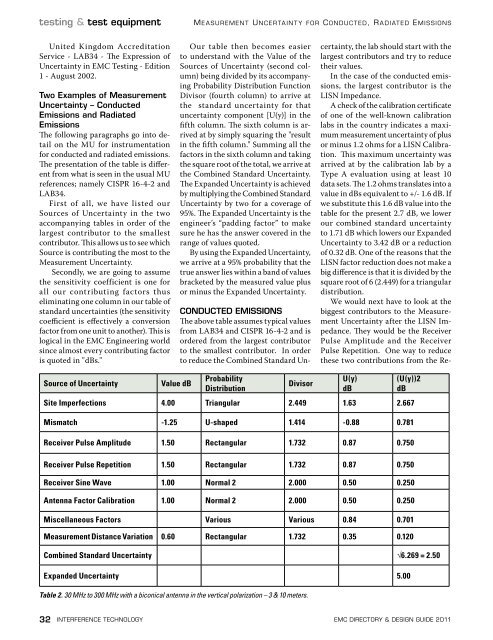

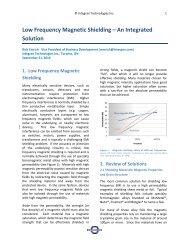

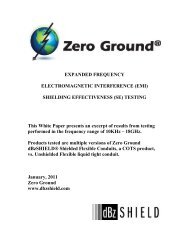
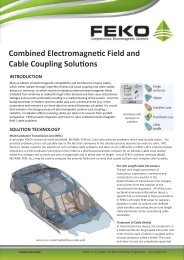



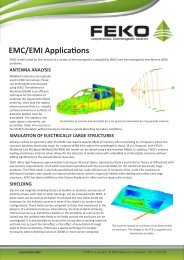
![[ thursday ] morning sessions 8:30 am-noon - Interference Technology](https://img.yumpu.com/23176841/1/190x247/-thursday-morning-sessions-830-am-noon-interference-technology.jpg?quality=85)
